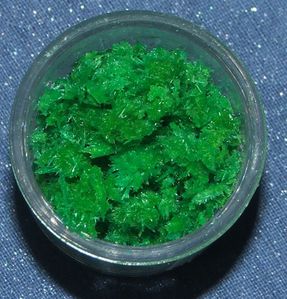June 8 2011
3
08
/06
/June
/2011
13:40
Warning: Copper(II) chloride is toxic. Do not eat the crystals or drink the solution. Avoid getting the acidic solutions on your hands or face. To be safe, wear gloves and goggles. Keep crystals out of reach of children, unless they have extreme copper deficiency and need the copper (do not take this last sentence seriously).
This article will describe several processes that can be used for creating this chemical.
- Mix hydrogen peroxide with hydrochloric acid. 30% peroxide is better than 3%. Add copper. A green solution of copper(II) chloride is produced. Evaporate and obtain the crystals. If you use 3% hydrogen peroxide, you may get next to nothing. As this experiment is very cheap, you can reproduce it with different levels of hydrogen peroxide and hydrochloric acid to find the ideal mixture. After trying this method, it works wonderfully. However, if not enough hydrogen peroxide is used, the copper reacts with the acidic copper(II) chloride solution to generate a dark green mixed copper(I)/copper(II) complex, which can cause problems as the salt dries, including the formation of an insoluble oxychloride or a monovalent chloride. Add a little more hydrogen peroxide if a dark green coloration is observed after dissolution is completed. If it changes color (gets more bluish), add more peroxide until it stops changing color. If the resulting blue solution is not clear, it means that there is not enough hydrochloric acid present. Add more HCl until the solution clears.
- Dissolve sodium bicarbonate in water. Strip two copper wires. Place them in the solution. Connect a 12VDC power supply to them. Hydrogen and copper(II) hydroxide and copper(II) carbonate are produced. The hydrogen is seen as bubbles at the cathode. Oxygen may be released as bubbles at the anode. A blue precipitate of copper compounds begins to form at the anode. Scrape the wires periodically to remove loose precipitate. Eventually, the wire will become so encrusted with black copper(II) oxide that the electrolysis will stop. Filter and dry the precipitate. You may reuse the solution for more copper electrolysis experiments. This precipitate is mainly basic copper carbonate. Add hydrochloric acid to it until most of it is dissolved and put it out to evaporate. The rest of the copper carbonate should dissolve and the solution should be very dark green. After evaporation, beautiful copper(II) chloride crystals should be in the container. This method produces more CuCl2 than the previous method but is not as simple. The picture shows about 5 grams of green CuCl2 dihydrate produced by that process. I prefer this method because of its high yield and uncomplicated procedure (joke). Update: In reality, it is very low yielding and a highly complicated procedure.
- Heat copper shavings and drop them in chlorine gas. This produces the brown anhydrous form of CuCl2.
- For a solution containing both copper and chloride ions without any pure copper(II) chloride, just mix blue copper sulfate solution, which tends to be more readily available, with sodium chloride to form the more greenish copper chloro complex.

This copper(II) chloride will be used in later experiments.


